The Economics and Statistics Division maintains archives of previous publications for accountability purposes, but makes no updates to keep these documents current with the latest data revisions from Statistics Canada. As a result, information in older documents may not be accurate. Please exercise caution when referring to older documents. For the latest information and historical data, please contact the individual listed to the right.
<--- Return to Archive
For additional information relating to this article, please contact:
December 16, 2020ANALYSIS OF NOVA SCOTIA'S CONSUMER PRICE INDEX FOR NOVEMBER 2020 TRENDS – NOVEMBER 2020
Nova Scotia’s All-Items Consumer Price Index (CPI) increased 0.2% year-over-year in November 2020. At the national level, consumer prices were up 1.0% from a year earlier. Compared to October 2020, monthly consumer prices increased 0.2% in Nova Scotia and 0.1% in Canada.
On a year-over-year basis, national CPI growth increased from 0.7% in October to 1.0% in November. Prices increased in six of the eight major components with shelter prices (+1.9%) contributing the most to the year-over-year increase.
Increased consumer spending on household durable goods supported higher prices for furniture and household appliances.
National rent prices rose 1.5% year-over-year, up from a 1.0% increase in October. November marked the fifth monthly increase in rent prices over the last six months. The homeowners' replacement cost index increased for the ninth consecutive month. Historically low interest rates coupled with a shift in preferences towards larger dwellings has increased demand for single-family homes. Higher building material costs and low inventory of homes for sale in some markets also contributed to rising new home prices.
Mortgage interest costs were down 0.9% month-over-month in November, following a 0.7% decline in October. Interest costs continue to fall on downward pressure from the Bank of Canada’s lower policy rate, which has contributed to a decline in borrowing costs as more Canadians renewed mortgages at lower rates.
Gasoline prices fell 11.9% year-over-year in November. Domestic and international demand remains low, and tightening public health restrictions in response to rising COVID-19 cases is weighing on global demand for gasoline.
Impact of COVID-19 on the Consumer Price Index
Statistics Canada continued special CPI program measures for November 2020. Due to COVID-19 impact on product availability, select sub-components of the CPI received temporary special imputations. The sub-indexes for travel tours, components of spectator entertainment, recreational services, and some components of use of recreational facilities and services in some areas were imputed from the monthly change in the all-items index - effectively removing the impact of these goods and services on the CPI. Due to new restrictions, the price indexes for beer served in licensed establishments, wine served in licensed establishments and liquor served in licensed establishments were imputed in Quebec. Air transportation that was purchased but cancelled is excluded from calculations. Additional details can be found in the technical supplement.
Prices increased year-over-year in all provinces except Prince Edward Island (-0.5%) and New Brunswick (-0.4%). Alberta posted the largest increase at 1.3%, followed by British Columbia (1.1%) and Ontario (0.9%).
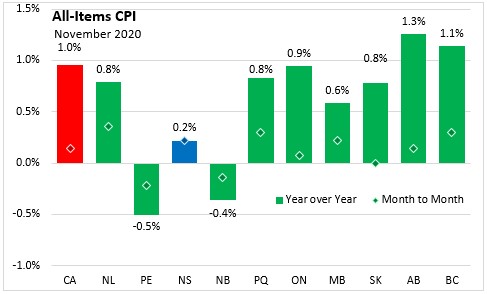
The main contributors to the monthly change (November 2020 vs. October 2020) in Nova Scotia CPI were:
- Rent (+1.3%)
- Women's clothing (+4.4%)
- Homeowners’ replacement cost (+1.5%)
- Gasoline (-3.3%)
- Telephone services (-1.7%)
- Fresh or frozen chicken (-11.1%)
Nova Scotia's consumer price inflation (year-over-year growth in CPI) excluding food and energy was 1.5% in November. All provinces reported year-over-year increases with the national rate at 1.3%. Newfoundland and Labrador (+1.8%), Nova Scotia and British Columbia (both at 1.5%) reported the largest price level increases, while Manitoba (+0.4%) reported the smallest increase. Compared to the previous month, the CPI excluding food and energy was down in Prince Edward Island and Alberta.
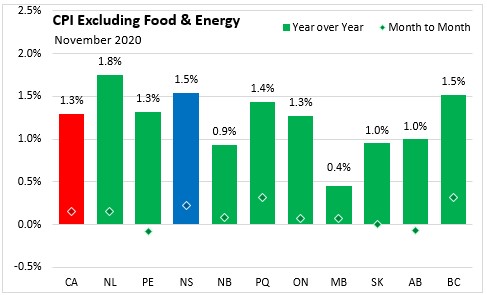
The CPI for food in Nova Scotia increased 1.6% year-over-year in November, down from a 1.9% increase in the previous month. Year-over-year, food prices increased in all provinces with the national average at 1.9%. The largest annual gain was recorded in Manitoba (+3.0%), while New Brunswick posted the smallest increase at 1.1%. Compared to last month, food prices increased in all provinces except New Brunswick. Food prices increased 0.4% month-over-month in Canada and 0.7% in Nova Scotia.

In November, the Nova Scotia energy price index decreased 13.3% compared to a year ago. Year-over-year energy price indexes decreased in every province except Alberta, with a national average decline of -5.7%. The largest annual decline was in Prince Edward Island (-16.2%).
Monthly energy prices (November 2020 vs. October 2020) were down in eight of ten provinces, with the largest decline in Prince Edward Island (-1.6%). Energy prices were down in Nova Scotia by 0.9% compared to October.
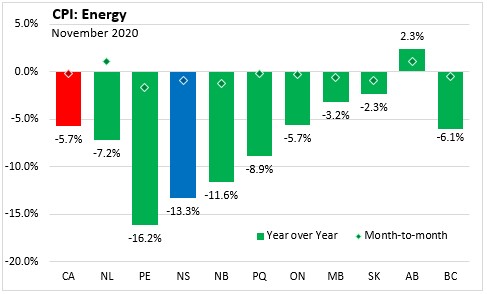
Year-over-year, Nova Scotia had the second largest decline in the consumer price index for shelter in November, with a decline of 0.4%. This was just behind the 2.1% decline registered in Prince Edward Island. For all of Canada, the shelter price index increased 1.9%, with the largest increases in Ontario (+2.6%) and British Columbia (+2.4%).
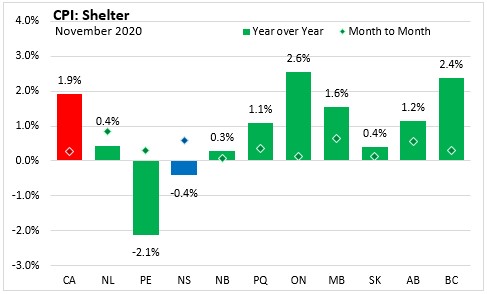
Nova Scotia's consumer price inflation (year-over-year growth in CPI) excluding energy was 1.6% in November compared to a national rate of 1.4%. The largest annual increase was posted in Newfoundland and Labrador (+1.9%) while Manitoba registered the lowest annual gain at 0.8%.
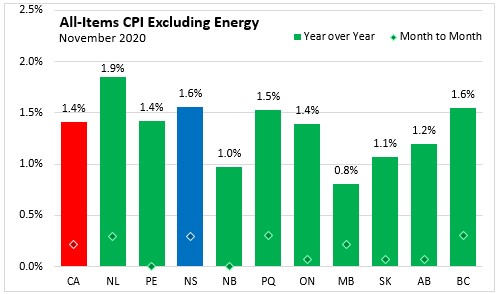
Major Components for November 2020
The following table shows the price increases specific to Nova Scotia for the major components of the CPI this month:
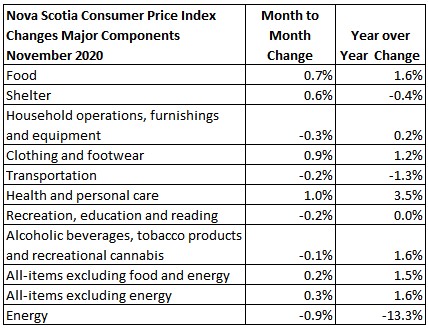
Long Run Trends
In November 2020, the All-Items CPI year-over-year inflation rate for Nova Scotia was 0.2%, below Canada's average at 1.0%. Nova Scotia's annual inflation has mostly been below the Canadian average since mid-2014, with the exception of only a few months. While month-to-month movements in the indices can be different, over time they generally follow the same overall trend. Nova Scotia’s year-over-year CPI inflation is currently at levels not seen since 2009.

Annual inflation for the CPI excluding food and energy in Nova Scotia (+1.5%) was higher than the national rate (+1.3%) in November 2020.

Bank of Canada's preferred measures of core inflation
Compared to November 2019, CPI-Common increased 1.5%, CPI-Median rose 1.9% and CPI-Trim was up 1.7% in Canada. All-items CPI excluding eight of the most volatile components as defined by the Bank of Canada and excluding the effect of changes in indirect taxes (formerly referred to as CPIX), rose 1.5% year-over-year.

Appendix Tables and Charts
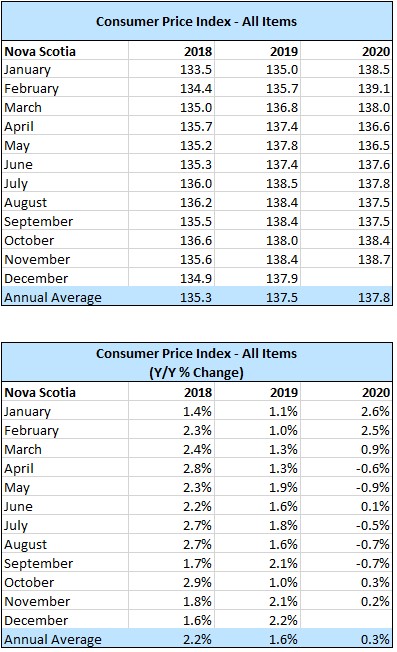
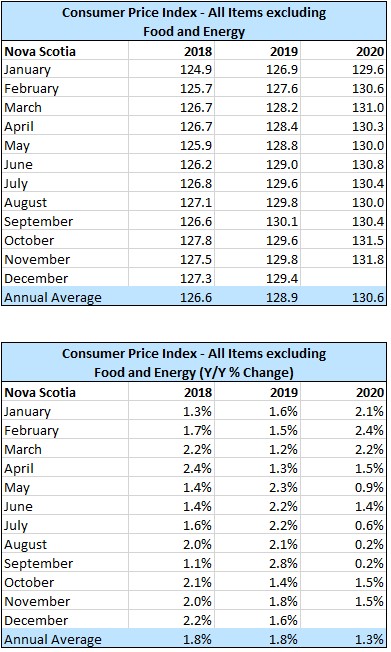
Source: Statistics Canada data portal: Tables 18-10-0004-01 and 18-10-0256-01
<--- Return to Archive